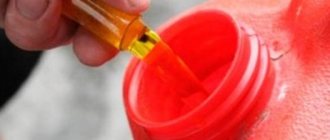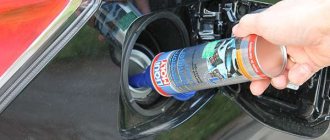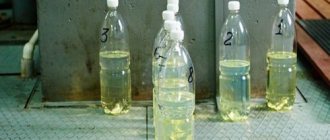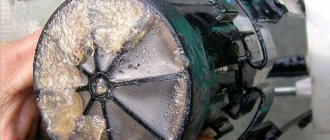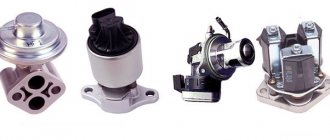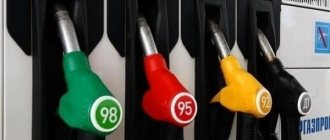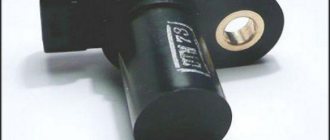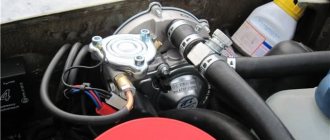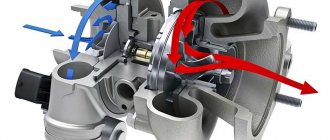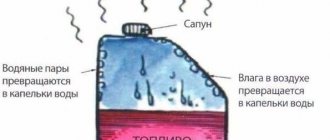Filling a car with gasoline is an ordinary task for drivers. In large cities, the chance of purchasing fuel of inadequate quality is negligible: they are all filled with networks of reliable gas station complexes. Today, it is extremely rare at gas stations to dilute fuel with water or various unknown additives. Only small gas stations can do this. You should purchase “power” for your car engine only at proven gas stations of a large network. After all, the cost of eliminating all the troubles caused by the entry of “hot stuff” into the gas tank can seriously hit your pocket. What is bad gasoline and what are the symptoms that indicate that such fuel was purchased at a gas station?
What kind of gasoline is called bad?
Poor quality gasoline can only be determined through laboratory testing. The driver's only tool is his eyes. The fuel should be clean and transparent in appearance. Gasoline from the bottom of a dirty container is also considered bad. This problem is typical even at gas stations of some reputable large chains. It is much worse when the manufacturer increases the octane number of gasoline through an additive package. The quality of normal fuel has long been regulated by standards. These standards allow the content of a certain amount of additives, benzene, and metals. If gasoline does not meet any criterion, it is called bad.
The following indicators fall under the standards:
- Octane number: indicates the degree of stability of the fuel before detonation.
- Sulfur: the less quantity it is present in gasoline, the better quality it is. When burned, it releases sulfur oxides, which form sulfuric acid with water vapor, which destroys virtually everything it touches.
- Water: the most common liquid on the basis of which “bodyaga” is diluted.
- Benzene: The presence of benzene in high-octane fuel is gradually being reduced due to the high toxicity of combustion products.
- Esters, alcohols: the percentage of alcohols included in high-quality gasoline is controlled. At an acceptable level (approximately 3-5%) they do not harm the engine. But a higher percentage of content contributes to increased consumption and the formation of fuel system plugs under the influence of high ambient temperatures.
- Arenas: They are also called aromatic carbons. Increases octane number. They have a detrimental effect on the fuel system pipes.
The driver can recognize the signs of bad gasoline only by the behavior of the car. Modern cars with different types of internal combustion engines react differently to fuel with an increased octane number. Sometimes the additive package is quite well selected and skillfully introduced. Most cars have at least once “eaten” and successfully “digested” bad gasoline poured into the gas tank. But it may happen that the engine of your particular car cannot withstand fuel with an increased content of naphthalene, ethyl, and acetone. That's why it's important to know the signs of low-quality gasoline.
How to claim compensation from a gas station?
If you become a victim of deception and fill up with bad gasoline, the gas station must answer for this misunderstanding. Rospotrebnadzor gave us complete instructions for action.
First of all, you must have a receipt. Without a receipt, any claims will be void. After detecting malfunctions, you must take the car to a service center and write a written complaint to the management of the gas station. Before starting repairs, gas station representatives must take fuel samples from the tank and send them for independent examination. If it confirms the poor quality of gasoline, then the gas station will bear the costs, otherwise the car owner will.
If there is no response to the claim, you can safely go to court and conduct an examination yourself.
What will be the symptoms of poor quality fuel?
You don't need to be a specialist or a driver with many years of experience to recognize the main symptoms of bad gasoline. They are as follows:
- The car doesn't start well.
- The car engine began to stall.
- Unstable speed at idle.
- The dynamics of the car dropped noticeably.
- Slow response of the gas pedal to pressure.
- During acceleration the car jerks.
- Knocks from the engine (probably detonation) became clearly audible.
- Fuel consumption increased by 15-20%.
- The color of the exhaust gases has changed.
All these symptoms indicate that bad gasoline was poured into the gas tank. It's not uncommon for the Check Engine light on your dashboard to turn on. You can unscrew the spark plugs and inspect their condition: red or black soot will indicate the need to change your usual gas station.
How to identify the problem
Every owner knows that low-quality gasoline can lead to car damage. The word “poor quality” here means fuel whose composition does not comply with established regulations and standards. The consequences of its use are very diverse, and some of them become clearly visible almost immediately after refueling:
- fuel consumption increases,
- the car starts poorly, does not start at all, or stalls quickly,
- the usual dynamics change,
- engine power decreases,
- The tachometer needle jumps at idle,
- Black or red carbon deposits appear on the spark plugs.
In other cases, the negative impact of fuel on the main systems of the machine may not be so noticeable, but the result will always be the same: failure of one of the components and subsequent, often expensive, repairs.
What to do in this case
First of all, stop the car and turn off the engine. The driver should get rid of low-quality fuel: pour everything out of the tank without a trace, then rinse the tank, fuel system, clean the injectors, replace the spark plugs. It would be even better to entrust this work to professional auto mechanics. Do not continue driving, call a tow truck and take the car to a service station. First, find the receipt from the gas station - this is the only evidence in case of further proceedings. Ideally, you should act like this if you fill up with bad gasoline:
- turn off the engine and call a tow truck;
- we return to the gas station, explain the claim and present the receipt;
- We call a mobile laboratory expert to analyze the fuel.
Situations are different: sometimes it is difficult to stop driving and call a tow truck. This is usually hampered by the weather (severe frost) and distance from the nearest populated area. But remember that by continuing to use, you act at your own peril and risk. If the car is new, the dealer has the right to remove it from the warranty: a catalyst destroyed as a result of operating the car on low-quality fuel is the responsibility of the driver. Even one unsuccessful refueling can leave a serious mark.
Consequences of bad gasoline:
- the operation of the entire fuel system is disrupted: sensors, filters suffer, injectors wear out;
- spark plugs deteriorate: it is the sparking elements that are the first to take a serious blow;
- valves wear out: exhaust valves are especially vulnerable due to incomplete combustion of the combustible mixture;
- further the catalyst is destroyed: the still “burning” mixture leaving the exhaust system will melt or destroy the catalyst, which will potentially lead to ceramic dust entering the engine cylinders through the EGR valve;
- parts of the cylinder-piston group suffer: due to uncontrolled ignition (detonation), the engine overheats, which leads to wear of the pistons and rings, scuffing occurs in the cylinders, compression and power drop.
These breakdowns do not occur overnight. Only systematic operation of the car on bad gasoline gradually reduces the engine's life.
What happens if you fill with low-quality fuel?
Now let's think about what will actually happen to the car if we fill it with such a cocktail at some gas station on the left:
- The fuel system is suffering . If aggressive additives are added, the filter and fuel pump in the tank, as well as the system itself, may be destroyed. If it’s just water or some unknown substance, the filter mesh will become clogged. And the more complex the system, the more damage can happen, for example, MPI system will not suffer so much, it will be enough to clean it (pump, filter, injectors), all because it does not have high pressure during operation. But if it is GDI, then both the high-pressure pump and the injectors themselves may suffer because they work differently with a different pressure and are located directly in the combustion chamber.
- Ignition system . The spark plugs are the first to take the hit; they can simply clog or even fail. This happens due to severe overheating (for example, low-quality additives have been added). Next, the ignition coils suffer, because they are actually connected to the spark plugs.
- Intake-exhaust system, exhaust and ecology. I decided to combine them into one because everything here is also interconnected. If the wrong additives are added, the octane number is different, let’s say much lower, then overheating is possible in the combustion chamber, the mixture does not burn out completely and therefore can burn the valves, the exhaust ones are especially affected. Of course, the knock sensor will try to align the ignition, but it is also not omnipotent. If the mixture, which is essentially still “burning”, goes into the muffler, it will meet with the catalyst , and it, in turn, can melt, the car’s power will drop, CHECK ENGINE will light up, all because the exhaust gases will not be able to escape normally. It is also possible that the catalyst may shed, in which case this “dust” may flow back into the cylinders through the EGR valve.
- Pistons, rings and cylinder walls . We have increased detonation in the cylinders, that is, uncontrolled ignition, and the engine is overheating. Pistons, rings suffer (by the way, they can melt), and also dust from the catalyst, all this has a very negative effect on the walls of the cylinder block. Seizures form, power and compression drop.
- Knock and oxygen sensors . The knock sensor (as it becomes clear) fights engine detonation; in fact, it is very simple and reliable, the principle of its operation is somewhat similar to a piezoelectric element. When low-quality fuel is filled, it is overloaded and may fail. The oxygen element (also known as a “lambda umbrella”) is located next to the catalyst (in some cars there are two of them), the main task is to detect oxygen in the exhaust; they can also melt from unburned fuel and fail.
As you can see, many different elements can be damaged, and this is only from refueling with low-quality gasoline. Of course, breakdowns will not be immediate, but if you don’t take action, they won’t keep you waiting.
How to avoid fuel problems
Try to follow simple rules:
- Buy gasoline only from gas stations you trust. For preventive purposes, periodically unscrew the spark plugs. Carbon deposits and deposits are a sure indicator of the use of low-quality fuel.
- Before arriving at a new gas station, pay attention to the landscaping of the territory: cleanliness, well-groomed conditions - indicators of the company’s growing reputation;
- Avoid buying “European fuel” at a small and unknown gas station.
- Be skeptical about low prices.
- Don't forget to pick up your receipt and keep it for as long as possible.
These tips will help you avoid many problems when purchasing fuel. Don't skimp on gas. It is better to overpay the “ruble” than to repair serious damage to the engine, fuel system, or catalyst.
How to drain low-quality gasoline from a tank?
On cars with an injection power system, you can drain low-quality gasoline from the tank using a jumper that connects the power circuit of the fuel pump. The easiest way is to force power through the fuel pump relay block. To do this, just turn on the ignition and close contacts “30” and “87” with a jumper. As a connector, you can use a wire of sufficient thickness or a piece of wire with a cross-section of at least 1.25 mm².
To drain gasoline into an empty container, you will have to disconnect the fuel supply line. You can do this in several ways:
- Disconnect the fuel supply wire at the point of connection to the fuel module. On most cars, you can access the section through the service hatch located under the rear seat. You will also need a hose, one end of which should be connected to the vacated fitting, and the other should be lowered into an empty container.
- Disconnect the supply hose from the fuel rail.
- Unscrew the service valve designed to measure fuel pressure in the rail (not installed on all types of power systems).
- Disconnect the quick-release connection of the sections of the fuel supply line from the tank to the ramp in any convenient place.
The choice of the line break point depends solely on the design features of the power system. On engines with a carburetor that do not have an electric fuel priming pump, without removing the tank, gasoline can be drained using a hose of sufficient length, one end of which will be lowered into the tank. Having created the initial vacuum, lower the second end of the hose into the empty container. The essence of the method and the associated risk of tasting gasoline are widely known and do not require description.
Correct owner actions
After the car owner has collected the appropriate package of documents, it is necessary to write an application addressed to the owner or operator of the gas station. The latter must respond to the application within the period established by law, and if he refuses compensation for damage, the car owner has the right to go to court.
When contacting the judicial authorities, it is better to first enlist the help of a car lawyer who will have extensive practical experience in working with such cases. It will be difficult to fight a case in court without the help of a lawyer. It is necessary to correctly draw up an application and prepare a package of documents, on the basis of which a decision will be made in the future to grant or refuse compensation for the loss.
conclusions
Getting compensation from a gas station for bad gasoline is difficult, but still possible. You will need to prove the fact that you refueled at this particular gas station; you will need to have an expert opinion that the fuel does not meet the standards, and the breakdown of the engine or fuel system occurred precisely because of low-quality gasoline and diesel. If the owner of the gas station does not want to compensate for losses on a voluntary basis, then you should go to court, based on whose decision you can receive the money owed to you.
11.08.2018
The Right Action
- You need to rinse the tank, naturally draining all the gasoline from there
- In this case, the fuel line requires cleaning
- Injectors are removed and checked
And it is recommended to do all this work in your service station. In addition to these procedures, they will be able to identify other damage.
Well, and most importantly, no matter what the cost of the work, after the examination you have appointed and if low-quality gasoline is identified, the gas station is obliged to pay you all your repair costs.
Let's summarize: Yes, you can fill the tank until the tank is full and get rid of the bad gasoline, but you should remember that even if you filled it up to full with 98, it still will not get rid of impurities in the total mass.
And it’s not yet clear whether this will save money or add problems in the future.
Or follow a different algorithm. Tow the car to a service station, pay for repairs, but try to prove the purchase of low-quality gasoline and return all expenses at the expense of the unscrupulous gas station.
It's up to you to decide, but it also happens that assumptions about problems in the car due to low-quality fuel are not confirmed. In this case, be prepared to pay for the examination.
Symptoms of low-quality fuel in the engine
Don't be fooled
“Bad gasoline can be felt and heard”—this is what experienced drivers say about determining the quality of fuel. Indeed, bad fuel poured into a car can help determine some symptoms. Let's look at the most important of them.
Detonation
The most common sign of bad gasoline is detonation knocks. According to car mechanics, in 80% of cases they arise precisely as a result of unsuccessful refueling. Their appearance is usually associated with the use of gasoline that has a lower octane number.
Since a similar symptom can also be caused by defects in the ignition system, in order to ensure the correct diagnosis, it makes sense to carefully check the functioning of the ignition system. If it's OK, it's probably due to the fuel.
Spark plug wear
The second most common manifestation of counterfeit gasoline is premature failure of spark plugs. European and American cars are most susceptible to such malfunctions.
As a rule, in this case, the client contacts the service with standard complaints indicating interruptions in the functioning of one (less often, several) cylinders: uneven engine operation, “ragged” idle jerks, including when driving at a constant speed, poor starting and increased fuel consumption.
Although there may be a lot of reasons that caused the quick “dying” of spark plugs, after removing the defective part, diagnosing low-quality gasoline is not difficult: it will be covered with an even red soot - a clear sign of an abundance of iron in the fuel. Moreover, it is usually not only the spark plug that has stopped working that is damaged, but also all the others: a reddish coating will also be visible on them. Sometimes, when driving for too long on bad gasoline, there are also traces of detonation erosion on the electrodes - it looks as if they have been eaten away by rust, the surface of the contacts becomes uneven and rough to the touch.
Defects of the ecological system
The third most common defect caused by pouring a surrogate is a failure of the car's environmental system, primarily the lambda zone - a sensor that controls the amount of oxygen in the exhaust gases. Even if the parts of the ecosystem are able to withstand the effects of the chemical components of the additives, their high concentration in the exhaust gases can cause incorrect car operation.
It looks like this: the car begins to “choke” during sharp acceleration. However, a check shows that everything is in good order: both the components associated with the fuel supply and the ignition system.
The reason for the car’s strange behavior is that the sensor that monitors the oxygen content in the car’s exhaust reacts to the ingress of foreign components that occur during the combustion of low-quality fuel. As a result, a signal is transmitted to the controller to reduce the content of gasoline and mixture. Which, in fact, is what he does. As a result, the car experiences acute fuel starvation under conditions of rapid acceleration or on a steep climb.
Know the behavior of your car and try to refuel only at proven gas stations!
